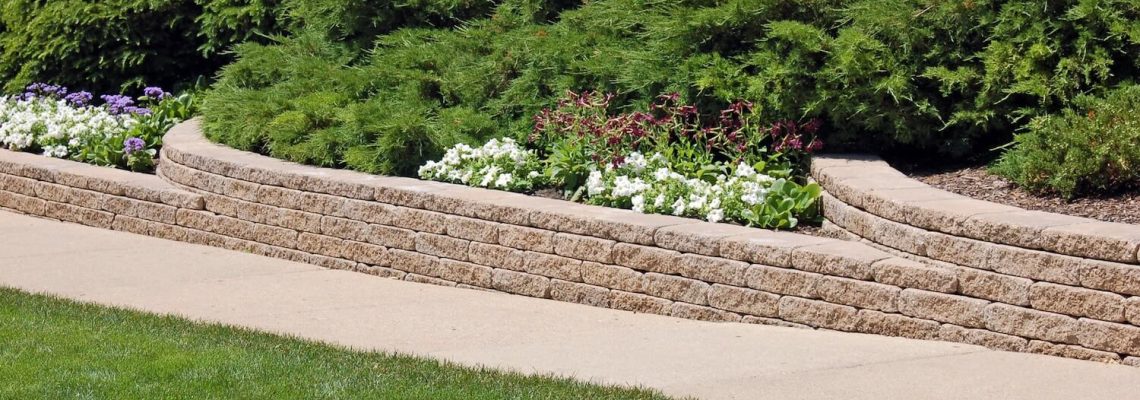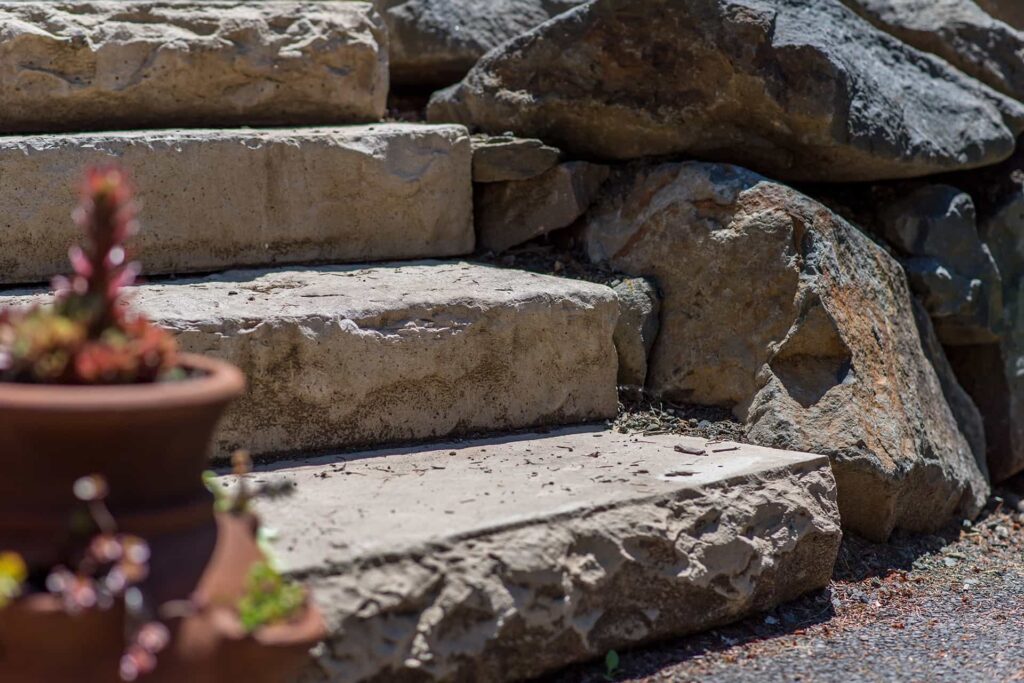Sloped yards can be beautiful—full of character, depth, and opportunity—but they can also be problematic if left unmanaged. Challenges like soil erosion, limited usable space, water runoff, and even safety hazards are all too common. If you’ve ever struggled to mow a steep hill or worried about water collecting near your foundation, then you understand the need for a better solution.
Retaining walls offer more than just a practical fix. They blend function and form to create landscapes that are not only structurally sound but also visually appealing and easier to maintain.
Whether you’re trying to prevent landslides, carve out a garden, or simply make your outdoor space more livable, retaining walls are a smart investment that stands the test of time.
1. Combat Erosion and Soil Movement
Slopes are naturally prone to erosion. When it rains, gravity pulls water—and everything it touches—downhill. This means topsoil, mulch, grass seed, and even plant roots can be slowly or quickly stripped away over time, leaving behind bare patches, exposed roots, and deep channels in your yard.
Retaining walls are specially designed to counteract this force of gravity. By holding the soil in place, they create a physical barrier that prevents soil from sliding. This is particularly important after heavy rainfall, snowmelt, or storms. Over time, the cumulative effect of unchecked erosion can lead to significant damage, not just to your landscape, but also to your home’s foundation if the slope directs water toward the structure.
Moreover, retaining walls can be engineered to include drainage pipes, weep holes, and geogrid reinforcements to distribute pressure and manage water flow behind the wall. This ensures that water doesn’t build up and compromise the wall’s integrity. When properly designed and constructed, a retaining wall becomes an essential line of defense against the elements, offering both peace of mind and property protection.
2. Create Usable Backyard Space in Challenging Terrain
One of the most compelling reasons to invest in a retaining wall is the ability to transform unusable slopes into functional, flat areas. Let’s face it—a steep hillside may be scenic, but it doesn’t make for a good patio, garden, or play area. Retaining walls let you reclaim your yard by leveling out sections into terraces or platforms that can be used for just about anything.
This process, known as terracing, is not only practical but also architecturally interesting. By creating distinct levels, you can design multiple “outdoor rooms,” each with a different purpose: a cooking area, a fire pit zone, a seating area, and more. These spaces can be designed with accessibility in mind, including built-in steps and railings, so that every part of your yard becomes usable and safe.
Families with children or pets particularly benefit from this transformation. A previously treacherous hillside can become a flat lawn where kids can safely play, or a garden that’s easier to tend without the risk of slipping or falling. In short, retaining walls maximize your land’s potential, giving you more square footage without changing your property lines.
3. Improve Slope Drainage and Water Control
Drainage is one of the most critical issues in landscaping, especially on sloped terrain. Water will always take the path of least resistance, and on a slope, that path usually leads directly downhill, carrying soil, mulch, and debris with it. If the slope directs water toward your home, garage, or patio, it can result in flooding, pooling, and long-term structural damage.
Retaining walls help you take control of how water moves across your property. Through the use of carefully planned drainage systems—like gravel backfill, perforated drain pipes, and weep holes—these walls can capture and redirect water in a controlled manner. This keeps your lower landscape areas dry and prevents soggy spots where grass and plants struggle to survive.
Beyond simply avoiding damage, effective drainage also promotes healthier plant growth by keeping soil intact and ensuring water doesn’t overwhelm plant roots. It’s not just about keeping water out—it’s about sending it where it’s most needed in a way that benefits your entire landscape.
If water management is a recurring issue on your property, pairing retaining walls with French drains or rain gardens can further enhance your drainage strategy, turning a frustrating problem into an eco-friendly solution.
4. Enhance Yard Landscape Aesthetics
While many people think of retaining walls in purely functional terms, the reality is that they can be a major aesthetic asset to your property. These walls provide structure, symmetry, and visual interest, breaking up a monotonous slope into elegant tiers or sculptural features that anchor your overall landscape design.
Retaining walls can be built using a variety of materials to match the style of your home and the surrounding environment. Whether you prefer the natural look of fieldstone, the clean lines of concrete blocks, or the rustic warmth of timber, there’s a design to suit every taste and budget.
What’s more, retaining walls can be customized with curves, steps, lighting, built-in benches, and planter boxes, adding functionality without sacrificing beauty. Lighting not only highlights the wall at night but also enhances safety and atmosphere. Built-in planters can soften the hardscape with lush greenery or colorful flowers.
A well-designed retaining wall becomes a statement piece in your yard, showcasing both form and function while contributing to an upscale, professional look that sets your home apart.
5. Boost Property Value and Curb Appeal
It’s no secret that landscaping improvements add value to your home, and retaining walls are no exception. A well-executed wall adds a sense of order, permanence, and beauty that buyers love. Studies show that attractive landscaping can add up to 15% to a home’s value, and retaining walls often play a central role in that boost.
Prospective buyers are often drawn to homes that make the most of their outdoor space. A sloped yard without any functional upgrades might be seen as a drawback—but with retaining walls in place, the same yard becomes a highlight. It’s a visual cue that says “this property is cared for, upgraded, and ready to enjoy.”
And it’s not just about resale. For homeowners who plan to stay put, the everyday joy of a well-designed yard adds immense personal value. Whether it’s hosting a barbecue on a leveled patio or relaxing in a terraced garden, the benefits are both tangible and long-lasting.
6. Support Outdoor Living Features
Modern backyards are more than just lawns—they’re extensions of your living space, complete with kitchens, dining areas, seating nooks, and fire features. But if your yard is sloped, installing any of these becomes a challenge. Retaining walls solve that problem by creating stable, level surfaces for your outdoor lifestyle.
Whether you’re installing a pergola, an outdoor kitchen, or even a pool, a retaining wall can create the platform and perimeter you need. It can also provide practical additions like built-in seating or privacy screening, giving your space a polished and purposeful layout.
Designers often use retaining walls to define separate zones within a yard. For example, a raised wall can surround a fire pit area with integrated seating, while another level might house a garden bed or water feature. This kind of intentional design creates flow, making even a small or tricky yard feel spacious and well-organized.
7. Reduce Long-Term Yard Maintenance
Sloped yards tend to require more attention. Whether it’s washing away mulch, mowing on a hill, or constantly reseeding eroded patches, the upkeep can feel endless. By leveling the landscape and stabilizing the soil, retaining walls drastically reduce the time and effort needed to keep your yard looking good.
They also make routine tasks safer and more efficient. Mowing a steep incline isn’t just frustrating—it’s dangerous. Terraced levels make maintenance easier, safer, and more enjoyable, whether you’re cutting grass, planting flowers, or hosting guests.
Over the long term, you’ll find that your yard becomes more predictable and less stressful to manage, freeing up time for the things you actually enjoy doing outdoors.
8. Offer Yard Structural Longevity with Proper Installation
One of the key reasons to invest in a retaining wall is the long-term value it offers—when installed correctly. A well-constructed wall can last for decades with minimal upkeep. It can support thousands of pounds of earth, resist water pressure, and handle changing weather conditions throughout the seasons.
However, professional installation is crucial. Retaining walls need the right foundation, drainage, backfill, and reinforcement to perform well over time. Attempting a DIY solution without understanding these factors can lead to cracking, bowing, or even collapse within a few years.
Professional hardscape contractors will consider factors like:
- Soil type and slope gradient
- Required wall height and materials
- Drainage needs and hydrostatic pressure
- Local building codes and permitting
Choosing an experienced contractor ensures you get a wall that’s not only attractive but also safe and structurally sound.
9. Environmentally Friendly Slope Landscaping Option
Retaining walls can also be a green choice. By controlling runoff and preventing erosion, they help maintain the integrity of your soil and reduce sediment pollution in nearby waterways. In areas prone to drought, retaining walls support efficient irrigation practices, keeping water where it’s needed most.
You can also use retaining walls to create eco-friendly garden beds, grow native plants, or even implement sustainable water features. When paired with rain gardens, bioswales, or permeable paving, they become part of a broader strategy for environmental stewardship.
In short, retaining walls help your yard work with nature, not against it, supporting sustainability in your own backyard.
10. Yard Customization for Any Budget or Outdoor Style
The beauty of retaining walls is their versatility. Whether you’re looking for a budget-friendly fix or a luxurious feature, there are options that fit your goals. Basic timber walls are affordable and effective, while premium natural stone installations provide a timeless, high-end aesthetic.
Retaining walls can be:
- Straight or curved
- Tall or low
- Plain or decorative
- Functional or ornamental
Work with your contractor to explore the full range of options. Even small touches like contrasting capstones, decorative lighting, or integrated stairs can take a simple wall from practical to showstopping.
Final Thoughts: Holding It Together, Landscaping Beautifully
A sloped yard might seem like a landscaping headache, but with the right solution, it can become your property’s most captivating feature. Retaining walls don’t just hold soil in place—they unlock potential. They protect your investment, elevate your outdoor lifestyle, and bring structure and beauty to spaces that were once off-limits or unusable.
Think of a retaining wall as the foundation of possibility. It allows you to build upward, outward, and creatively—turning a plain hill into a terraced garden, a patio oasis, or a functional play space. It’s not just about preventing problems; it’s about creating opportunity.
Whether you’re envisioning weekend gatherings on a level lawn, a show-stopping garden that turns heads, or simply a safer, low-maintenance yard you can enjoy with peace of mind, a retaining wall can make it all happen.
So, if you’ve been struggling with a steep or unruly yard, now is the time to stop working against the slope and start designing with it. With the right retaining wall, you won’t just hold it together. You’ll elevate everything around it.


